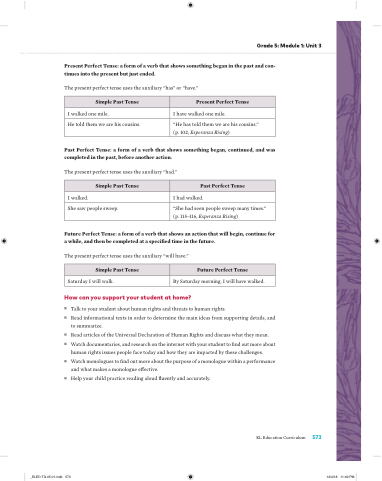Page 597 - EL Grade 5 Teacher Guide
P. 597
Grade 5: Module 1: Unit 3
Present Perfect Tense: a form of a verb that shows something began in the past and con- tinues into the present but just ended.
The present perfect tense uses the auxiliary “has” or “have.”
Past Perfect Tense: a form of a verb that shows something began, continued, and was completed in the past, before another action.
The present perfect tense uses the auxiliary “had.”
Future Perfect Tense: a form of a verb that shows an action that will begin, continue for a while, and then be completed at a speci ed time in the future.
The present perfect tense uses the auxiliary “will have.”
How can you support your udent at home?
■ Talk to your student about human rights and threats to human rights.
■ Read informational texts in order to determine the main ideas from supporting details, and
to summarize.
■ Read articles of the Universal Declaration of Human Rights and discuss what they mean.
■ Watch documentaries, and research on the internet with your student to nd out more about human rights issues people face today and how they are impacted by these challenges.
■ Watch monologues to nd out more about the purpose of a monologue within a performance and what makes a monologue e ective.
Simple Past Tense
Present Perfect Tense
I walked one mile.
I have walked one mile.
He told them we are his cousins.
“He has told them we are his cousins.” (p. 102, Esperanza Rising)
Simple Past Tense
Past Perfect Tense
I walked.
I had walked.
She saw people sweep.
“She had seen people sweep many times.” (p. 115–116, Esperanza Rising)
Simple Past Tense
Future Perfect Tense
Saturday I will walk.
By Saturday morning, I will have walked.
■ Help your child practice reading aloud uently and accurately.
EL Education Curriculum 573
_ELED.TG.05.01.indb 573
12/4/18 11:49 PM


